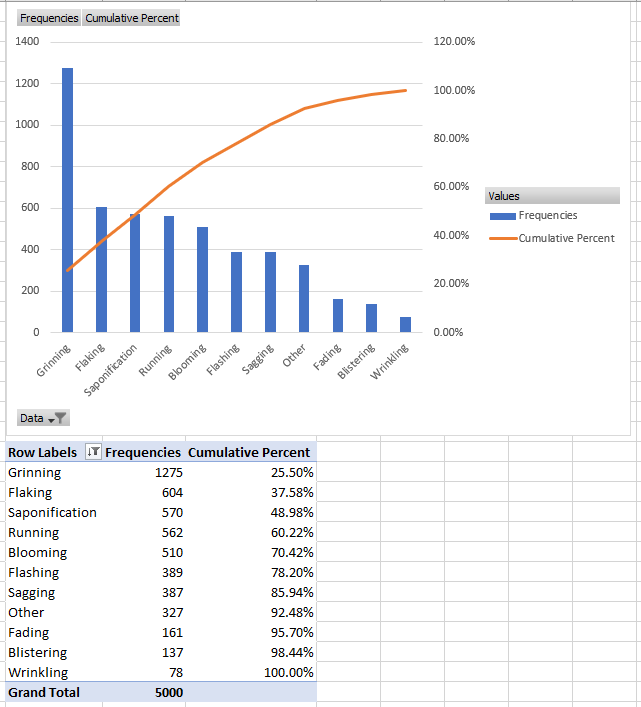DMAIC definition
DMAIC is an acronym that summarizes a Lean Six Sigma methodology for solving difficult problems with existing processes. The phases provide a structure that makes success more likely. Each letter stands for a phase in the DMAIC process.
D: Define
M: Measure
A: Analyze
I: Improve
C: Control
Want to learn more about the Lean Six Sigma methodology?
Check out this ebook that will guide you through the key concepts of LSS.
DMAIC process
The DMAIC model uses a process defined by the steps associated with each initial that makes up the acronym, as follows:
Define
At the beginning, you might not even have identified what problem to work on. You’ll often use DMAIC tools like Pareto analysis and Supplier-Input-Process-Output-Customer (SIPOC) diagrams to help understand which problems are leading to the biggest costs.
At the end of the define phase, you typically produce a project charter that describes elements like who will work on the problem, the project goals, and the benefits of achieving those goals.
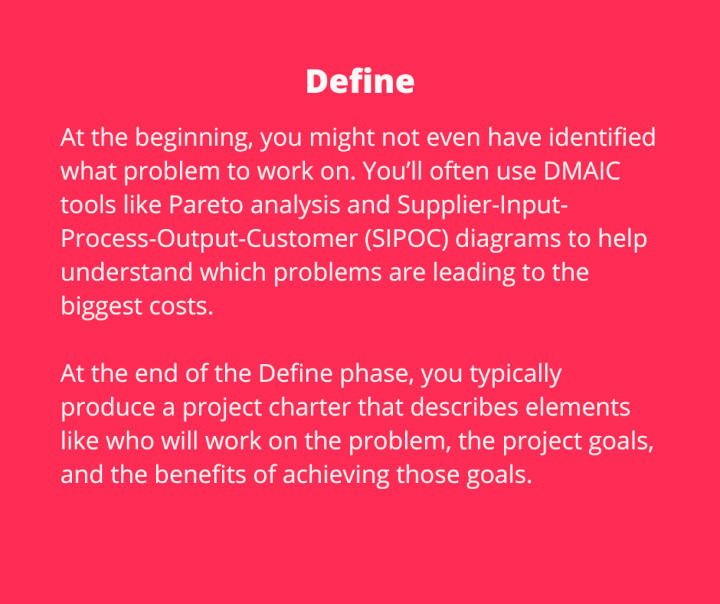
Define example
The following chart helps to clarify that “grinning” is the biggest problem with a painting process:
Measure
During the measure phase, you’ll want to make sure that the process that you have for measuring the process is adequate and determine the current state of the process.
You might need some of the more analytical DMAIC tools from Measurement Systems Analysis (MSA) to help decide when you are measuring well enough to understand the process to improve.
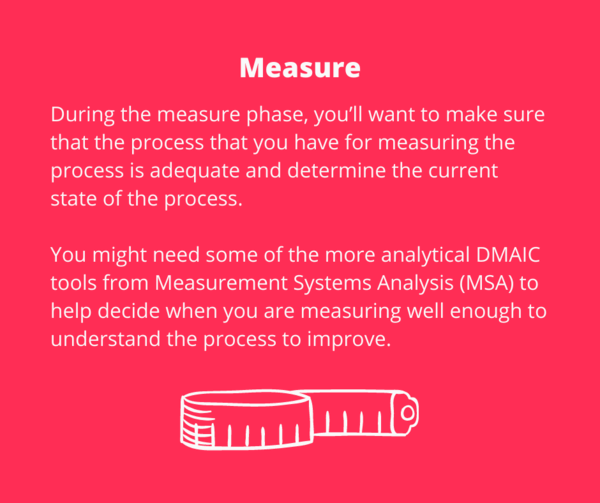
Measure example
If we do not presently measure how long it takes a medical resident to complete the required documentation of a surgical procedure for their education after the surgery, then we won’t be able to tell when the process has improved.
First, we would need to define the start and end points of the process as we’ll measure them, so that we can arrive at a measurement in days or hours.
Analyze
With the problem defined and the ability to measure the process in place, you are in a suitable position to look at what might be causing the problem.
You might use a 5 Whys Analysis to refine the problem statement into a testable form. Once you have some good ideas, designed experiments can verify that a potential cause has a significant effect.
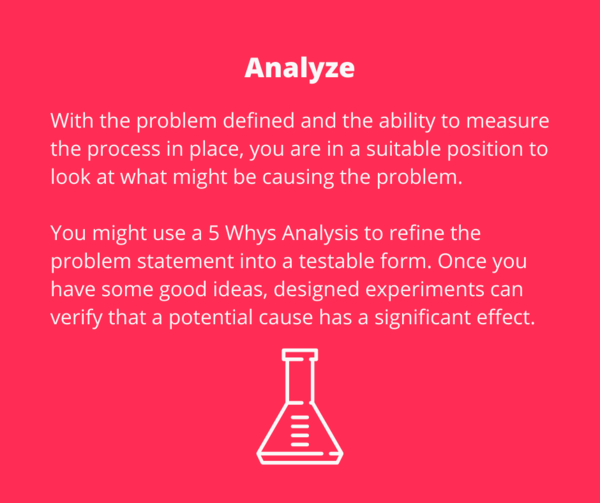
Analyze example
In a DMAIC example from a grinding process, the analyze phase is when the team determined that over 80 percent of the downtime for a machine was due to only three problems, although more than 10 problems had been considered.
Improve
During the analyze phase, your understanding of the process will have solidified so that you know what changes to make to improve the process. During the improvement phase, you’ll make sure to deliver those improvements to the full process.
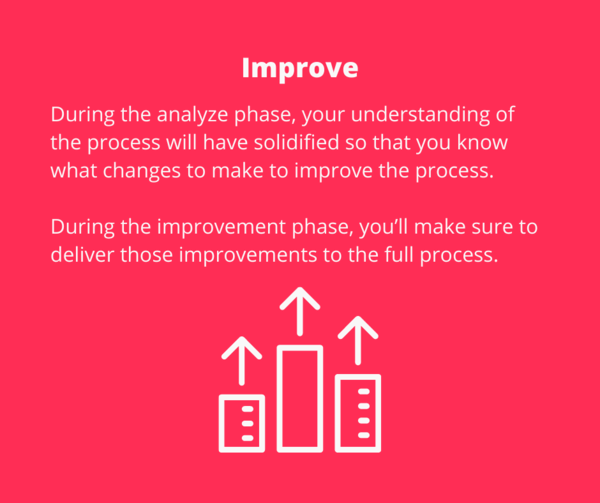
Improve example
In a DMAIC example on pumps, the analyze phase showed that operators had to hold a part too hard to keep it still, resulting in deformation of the part from three points of contact of the holding tool.
In the improvement phase, the team using the DMAIC model distributed a new tool that provided even pressure instead of pressure at three points.
Control
Now that you’ve improved your process, it’s critical that you make those improvements part of the standard operating procedure for the process. You’ll come up with a control plan that describes the new process and you’ll implement a monitoring plan that lets you verify that the improvements are stable.
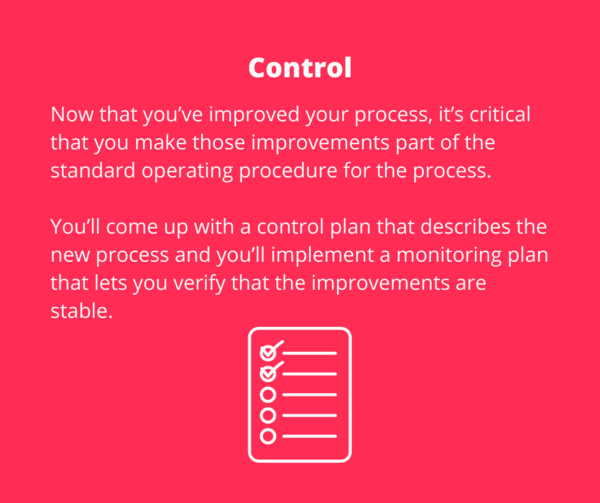
While we generally hope that control charts at this phase show you a process that’s predictable, it’s important that the control phase also lets you know about process changes that represent opportunities for improvement.
DMAIC diagram
The DMAIC model is often circular, as in the following DMAIC diagram:
 As you monitor your improved process, you’ll often identify new problems that you can solve by returning to the beginning of the DMAIC process. In a DMAIC example from higher education, in addition to the gains in the process the team was improving, the DMAIC methodology revealed two new problems that were good candidates for process improvement.
As you monitor your improved process, you’ll often identify new problems that you can solve by returning to the beginning of the DMAIC process. In a DMAIC example from higher education, in addition to the gains in the process the team was improving, the DMAIC methodology revealed two new problems that were good candidates for process improvement.
DMAIC tools
We’ll often find that specific Lean tools are common to use at particular phases of DMAIC. The following list gives a few common tools by phase. Although tools are often most typical in particular phases, you can find uses for many tools in multiple phases. For more details on the tools in the list, go to our Lean Six Sigma tools and techniques resource.
Define
- Failure Mode & Effects Analysis (FMEA)
- Process Flow Charts
- Project Charter
- RACI Matrix
- TAKT Time
- Value Stream Map
Measure
Analyze
- 5 Whys Analysis
- Design of Experiments
- Fishbone Diagram
- Regression Analysis
Improve
- 5S
- A3 Process/Report
- Kanban
- Kaizen
- Poka Yoke (Error-Proofing)
- Total Productive Maintenance (TPM)
Control
- Control Charts
- Standardized Work
- Statistical Process Control (SPC)
Learn more
This resource introduced the DMAIC model with some examples and prospective tools. To learn more, try our Lean Six Sigma courses, designed to prepare you for certification with IASSC/PeopleCert.
Prepare to get certified in Lean Six Sigma
Start learning today with GoSkills courses
Start free trial
